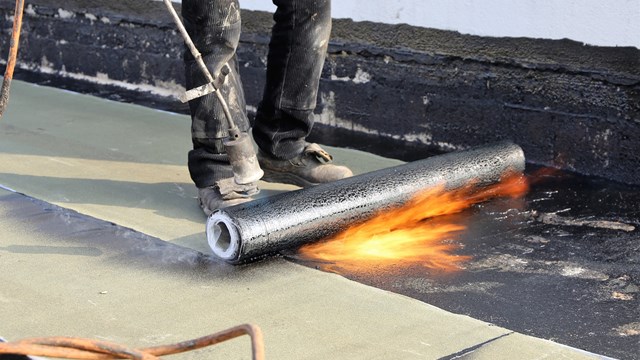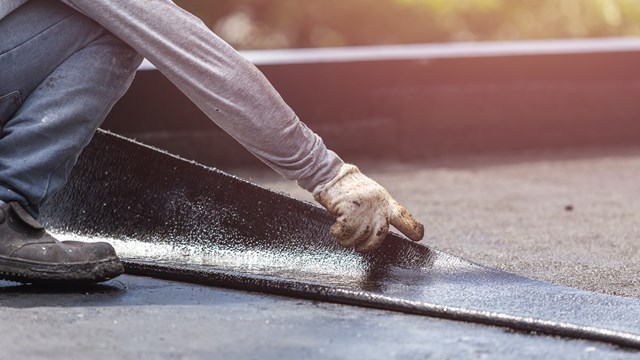No two ways about it–appearance counts, and chances are when you decided to buy into your building, part of your decision was based on whether the building appealed to your eye. Now you and your fellow board members find that the passage of time, crumbling features, eroded detail work, urban grime, and some unsightly (if creative) graffiti have helped you make up your minds to get some work done on the old place. Or perhaps you’ve just been inspected, and the authorities kindly insist that you make some improvements, post haste. Or maybe spring has sprung, housecleaning is in the air, and your building just needs some sprucing up.
The Good, the Bad, and the Dirty
While everybody who passes by may not realize that your building’s pigeon gray exterior should actually be dove white, you and your neighbors probably don’t care much for living in a crud-coated domicile. What do you do? How do you find a reliable contractor to attend to something this important? "Word of mouth has got to be the most valuable way," says Wayne Bellet, president of Bellet Construction Co., Inc. in Manhattan, whose family has been in the business for generations. People who know buildings know people who know how to clean buildings. You can research your options by reading trade papers and magazines, going to trade shows, and asking around. Compile a list of likely candidates for the job, and interview each contractor on your list.
Once you’ve narrowed the field to a final few, the hopefuls will submit their bids for your job. While it may be tempting to go with the company or contractor that offers you the most attractive price or shortest time frame, it’s important to remember that there’s more to this than just how long the project will take and how much it will cost.
Bellet advises boards to make sure their contractor is fully licensed and accredited, of course, but also to find out what jobs he or she has done, what buildings he or she has worked on, and what industry organization boards he or she serves on or is affiliated with. Bellet puts it bluntly: "Most contractors do lousy work; there are very few of us that are good at it. If your [façade]-cleaning person says it’s his third job, show him the door. Don’t be a guinea pig."
According to Bellet, after securing the services of a reputable cleaning and repair contractor, "The first thing you can do is attend to aesthetics." Buildings in New York City get dirty quickly–there is no avoiding it. Car exhaust, grit, grime, soot, ash, and dust all contribute to the dingy advance up the side of your home.
Your first reaction to the grunge might be the same as it was in your old college dorm when you feared losing your deposit: just slap on a fresh coat of paint, and problem solved. It may seem like a nice, inexpensive idea, but Bellet warns that paint is literally not all it’s cracked up to be.
First of all, says Bellet, you should never paint something that hasn’t been painted before: all you will do is compound your troubles. A crisply painted building may attract the eye, but even the best, most professional application of paint will only last five to seven years. The harsh city environment will cause paint to fade and peel, and ambient dirt and graffiti take their toll as well.
Alan Epstein, president of Epstein Engineering in Manhattan, agrees, saying that every building–constantly exposed to the hard world that is New York–will need to be deep-cleaned and fixed up periodically, not just masked with a layer of paint.
When to Start
After your contractor has done a preliminary examination of your building and decided how to restore it, he or she will confer with your board or managing agent to arrange a time for the cleaning operation to take place. There’s no set "season" for façade-cleaning, but because of the amount of water and other liquid cleaning agents needed to do the job–and in consideration of the workmen’s comfort and efficiency–very little cleaning work is done during the cold winter months.
How long the cleaning job will take and how much it will cost depends on a number of factors. The size of the building figures largely into the bottom line, as does how dirty the façade is. A basic cleaning job can take from a single day to seven weeks, and the final cost will reflect how much time the workers spend on the scaffolding itself. A six-story building typically costs $3 to $10 per foot to clean. Other contingencies affect cost as well. Your contractor will be unable to clean paint when doing raw masonry, for example, so if your board predecessors thought themselves clever for putting new paint on instead of springing for a proper cleaning in years past, their quick-fix alternative may return to haunt–and inevitably cost you, as the paint will have to be stripped and then repainted.
There is also the issue of when to make any repairs to your façade: before or after cleaning? Opinions on this matter vary, even among the pros. According to Paul Millman, PE, RA of Superstructures Engineers + Architects in Manhattan, "On the one hand, if you clean the building first, the cracks and other issues become evident," giving you a more thorough picture of what repairs are needed. On the other hand, however, Millman says "Repair work is a dirty business, with a lot of mortar and dust, so a post-repair cleaning can be a good way to wrap things up, as well as for a psychological good feeling" upon ending the project.
Bellet generally agrees, comparing the process to replacing a missing tooth. You can get a brand new, pearly-white tooth put in and then spend time and money bringing your existing teeth up to the whiteness of the new one, or you can match a new tooth to the color of your old ones. Both options have arguable merits and drawbacks, but Bellet finds himself also recommending cleaning after any repairs are made, if only because a contracted repair job can cost more than you anticipated, and you may find that after shelling out for capital improvements, that irksome pigeon gray exterior isn’t such a problem anymore.
Lather, Rinse, Repeat
There are three main ways to clean a building, according to Millman, you can use water, solvents, or abrasives. Each method differs in time and cost, as well as in materials. Water cleaning is just that–good old H2O is applied at varying pressures to hose off the dirt.
Solvents are chemical agents that strip dirt from building surfaces. The agents used in solvents range from acidic to basic with some even composed of citrus fruit acids, says Millman. These chemicals do clean a building somewhat faster than plain water, but they also cost more. And of course, where chemicals are involved, there are environmental considerations that may affect both the cost and the time it takes to complete the project. Chemical manufacturers also change their formulas regularly, says Millman, and contractors should stay abreast of what sorts of agents are being included in new formulations.
The third way to erase years of accumulated filth is through the use of abrasives. Years ago, the scouring agent used to treat buildings was fine sand that blasted the façade clean and exposed the unsullied material underneath. Years of sandblasting treatments, however, had the same effect on buildings as years in the desert has on rock formations: it eroded them, blunting artful details and doing more harm than good in many cases. Today, says Millman, façade cleaning crews use kinder, gentler abrasives like pulverized walnut shells and buckwheat hulls to scrub off stubborn grime. Abrasive cleaning is very effective, but since it’s a far more delicate procedure and a special rig must be erected to collect all the dust and particles being used, it’s also the most expensive and time-consuming way to get your building to sparkle.
More often than not, cleaning contractors use a combination of water and solvents to get a given job done. First, a pH-lowering pre-wash is applied to the building’s exterior to loosen caked-on grime and prepare the surface for Step Two. Next, high-powered hoses blast off the pre-wash and a chemical detergent is applied and allowed to set. After that, more power hoses blast off the detergent. The detergent is reapplied and re-blasted as necessary–depending on the tenacity of the dirt–after which a neutralizing solution brings the pH level of the building’s exterior back to normal.
According to Bellet, the detergent used by most urban building-swabbers is "environmentally green," that is, safe to be used on buildings and washed off into the streets. "You can even drink it if you want to," says Bellet, though he certainly doesn’t recommend it. Getting a thorough cleaning depends not only on how much detergent you put on and how long you let it sit, but also how you remove it. Equipment is important, too; the high-pressure washers used to blast grime off buildings can shoot water at anywhere from 3,000 to 30,000 pounds per square inch. That’s "enough [force] to shear your fingers off," according to Bellet.
Water with that kind of pressure behind it can easily blast the assorted grunge off your building, but in the hands of a careless or inexperienced workman, other things can be blasted off as well–like bits of loose brick, or delicate ornamental elements. It’s therefore vital that you not only hire experienced, conscientious professionals because, as Bellet points out, "an unsupervised brute can do damage to a building," but that before cleaning begins, you also discuss with your façade pro any repairs that might need to be made.
Millman also suggests that "If a contractor recommends anything other than water, it makes sense to get an architect or engineer involved as they don’t have a vested interest," in what type of cleaning is ultimately used. The objective professional can advise your board on which cleaning methods are most appropriate for your building based on its age, materials, and relative dirtiness. Millman also recommends doing test panels on your façade using each cleaning method to determine which effect is most satisfactory.
Compliance With the Law
A variety of laws are on the books to ensure the well-being of buildings and their inhabitants. Local Law 11, for example, stipulates that buildings with six stories or more be inspected for soundness every five years by a licensed engineer or architect. Local Law 10–Local Law 11’s precursor–just required inspection from the front of the building to twenty feet back, but the newer law mandates that the entire perimeter be gone over, which means considerably more surface area to worry about.
According to Epstein, the average inspection takes between two and three days and costs between $2,000 and $3,000. The building owner pays the fees for Local Law 11 inspection and filing, and then can determine within a two-year margin when the inspection will actually take place. According to Bellet, if the inspector finds hazards during inspection, the owner is required by law to address the situation immediately, "as though it were a fire. [But] once the shed is up, you are code compliant."
The "shed," also known as the "bridge," is the wood-skirted scaffold constructed around a building while façade work is being done that keeps bits and pieces of masonry and debris from falling on to unsuspecting pedestrians below.
Superglue?
Every façade specialist or Local Law 11 inspector has tales to tell of absurd–if not creative–measures taken by building owners to make minor repairs. Bellet recalls seeing "bathroom caulk being used to hold stone together in the middle of winter," and chunks of cracked marble "held together with a carton of superglue."
Temporary measures aren’t uncommon, says Epstein, but "certain elements tend to deteriorate and need larger ongoing maintenance." Protruding ornamentals such as carvings and exposed concrete require repair work that is complex in and of itself. Of course, the final cost to a building will reflect the type of façade, the number of decorative elements, and the extent of damage, but Epstein estimates that a board can expect to shell out anywhere from a couple of thousand dollars into the millions for a façade overhaul, and from a one-day fix to eight years of brick stripping.
Clearly, the advent of Local Law 11 has revolutionized the business of façade cleaning and repair, which–while good for contractors’ business–also benefits boards because there are now more people who are knowledgeable about your building’s preservation. Professional knowledge improves with every job, too. As Bellet says, "[Façade work] has always been a trade, but it’s now becoming a craft."
Brady Richards is a freelance writer living in Brooklyn.







Leave a Comment